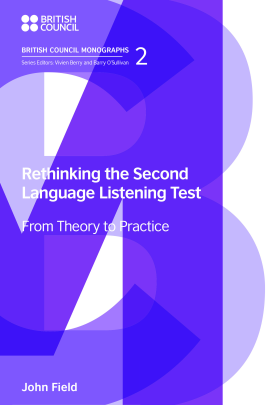
Rethinking the Second Language Listening Test
From Theory to Practice
Rethinking the Second Language Listening Test argues that the key to more valid testing of second language listening lies in a better understanding of the nature of the skill and of the signal that listeners have to decode. Using this information as a point of departure, it takes a critical look... Read more
Published: 2018
Pages: 167
eBook: 9781781797143
Rethinking the Second Language Listening Test argues that the key to more valid testing of second language listening lies in a better understanding of the nature of the skill and of the signal that listeners have to decode. Using this information as a point of departure, it takes a critical look at many of the myths and conventions behind listening tests and provides practical suggestions as to the ways in which they might be rethought. The book begins with an account of the various processes that contribute to listening in order to raise awareness of the difficulties faced by second language learners. The information feeds in to a new set of descriptors of listening behaviour across proficiency levels and informs much of the discussion in later chapters. The main body of the book critically examines the various components of a listening test, challenging some of the false assumptions behind them and proposing practical alternatives. The discussion covers: the recording-as-text, the recording-as-speech, conventions of test delivery, standard task formats and item design. Major themes are the critical role played by the recorded material and the degree to which tests impose demands that go beyond those of real-world listening. The following section focuses on two types of listener with different needs from the general candidate: those aiming to demonstrate academic or professional proficiency in English and young language learners, where level of cognitive development is an issue for test design. There is a brief reflection on the extent to which integrated listening tests reflect the reality of listening events. The book concludes with a report of a study into how feasible it is to identify the information load of a listening text, a factor potentially contributing to difficulty.
John Field is Reader in Cognitive Approaches to Language Learning at the CRELLA Research Institute, University of Bedfordshire. He previously taught at the University of Reading, UK. He has a long-term interest in second language listening, on which he has written and researched widely; his Listening in the Language Classroom (CUP, 2008) has become a standard work in the field. His thinking is very much formed by his background in psycholinguistics, on which he has published a reference work. He has given consultancy advice on the testing of listening to several international test providers; and has fostered a new area of study evaluating the extent to which tests of second language skills elicit the kind of processes that candidates use in the real world. Recent research projects include advising on listening standards in Rwandan schools and investigating the effects of double play upon scores and candidate behaviour in listening tests. In an earlier life, John was an ELT teacher trainer, schools inspector and materials writer. Besides listening materials, he wrote national coursebooks for Saudi Arabia, radio programmes for the BBC World Service and TV programmes for the Open University of China.
| Cover | Cover | ||
|---|---|---|---|
| Contents | v | ||
| List of figures and tables | viii | ||
| Acknowledgements | ix | ||
| INTRODUCTION | 1 | ||
| A COGNITIVE MODEL FOR TESTING LISTENING | 5 | ||
| Chapter 1 | 7 | ||
| Chapter 2 | 14 | ||
| Chapter 3 | 20 | ||
| RECORDED CONTENT | 33 | ||
| Chapter 4 | 35 | ||
| Chapter 5 | 55 | ||
| TASK CHARACTERISTICS | 71 | ||
| Chapter 6 | 73 | ||
| Chapter 7 | 79 | ||
| Chapter 8 | 87 | ||
| LISTENER ROLES | 97 | ||
| Chapter 9 | 99 | ||
| Chapter 10 | 112 | ||
| POSTSCRIPT | 117 | ||
| Chapter 11 | 119 | ||
| Chapter 12 | 130 | ||
| APPENDIX A | 135 | ||
| APPENDIX B | 139 | ||
| References | 142 | ||
| Index | 152 |
